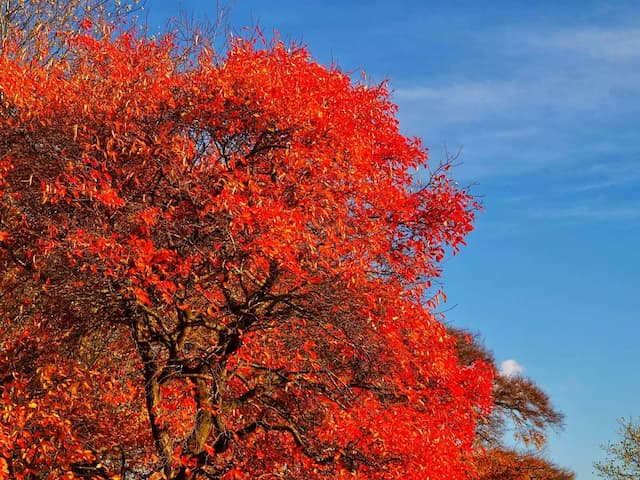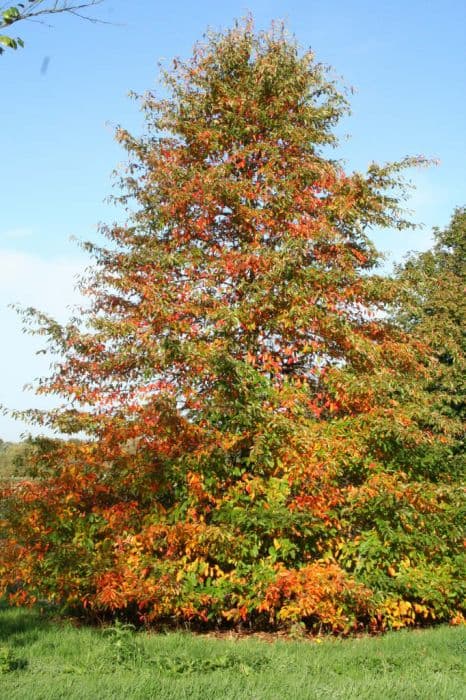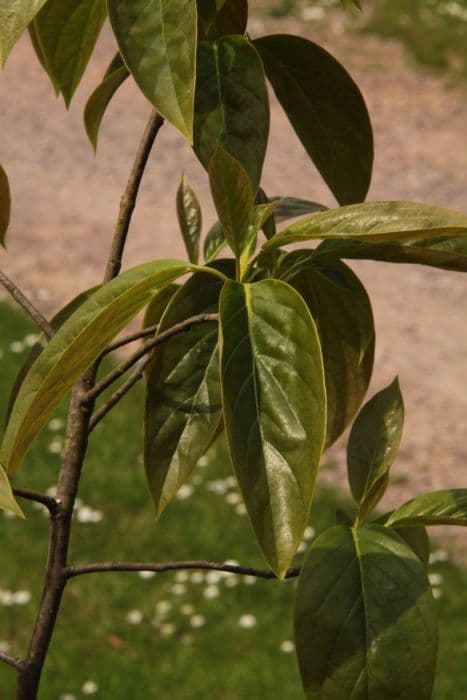Chinese tupelo Nyssa sinensis

ABOUT
N. sinensis is a spreading deciduous tree or large shrub to 10m, with narrowly-ovate leaves to 15cm in length, bronze when young and turning to yellow and red in autumn. Flowers inconspicuous; fruits small, black, seldom seen
About this plant
 Names
NamesSynonyms
Chinese Tupelo, Chinese Gum, Chinese Tupelo Gum
Common names
Nyssa sinensis.
 Characteristics
CharacteristicsLife cycle
Perennials
Foliage type
Deciduous
Color of leaves
Green
Height
20-30 feet (6-9 meters)
Spread
20-30 feet (6-9 meters)
Plant type
Tree
Hardiness zones
6-9
Native area
China
Benefits
 General Benefits
General Benefits- Aesthetic Appeal: Nyssa sinensis, commonly known as Chinese Tupelo, adds visual interest to landscapes with its attractive glossy green leaves and brilliant autumn coloration.
- Habitat Support: It provides habitat and food for wildlife, such as birds and small mammals, which feed on its fruits.
- Shade Provider: Chinese Tupelo grows to a substantial size, offering ample shade in gardens, parks, and natural landscapes.
- Erosion Control: With its robust root system, the Chinese Tupelo helps stabilize soil and prevent erosion in areas where it is planted.
- Climate Resilience: Adapted to various climates, it can withstand a range of conditions, making it a resilient choice for changing environmental conditions.
- Ornamental Uses: Chinese Tupelo is often used for ornamental purposes, featuring in garden design for its seasonal interest, especially in fall.
 Medical Properties
Medical PropertiesThis plant is not used for medical purposes.
 Air-purifying Qualities
Air-purifying QualitiesThis plant is not specifically known for air purifying qualities.
 Other Uses
Other Uses- Nyssa sinensis, commonly known as Chinese tupelo, can be used in woodworking to create decorative veneers or inlays for furniture due to its attractive grain.
- Chinese tupelo can be crafted into musical instruments, such as flutes or ocarinas, for a unique wood aesthetic and resonance.
- The wood from Chinese tupelo trees may be used in the production of specialty hand-crafted items like bowls or cutting boards because of its fine texture.
- The dense foliage of Chinese tupelo can be utilized in landscape design for creating shaded areas in gardens and parks.
- Chinese tupelo's colorful autumn leaves can be collected and used to create natural dyes for fabric or for art projects.
- The fallen leaves of the Chinese tupelo can also serve as a mulching material to improve soil health and conserve moisture around plants.
- Beekeepers may value Chinese tupelo as a nectar source to produce unique, location-specific honey varieties.
- Branches and twigs of the Chinese tupelo can be used in floral arrangements or as part of natural decorative motifs due to their structural beauty.
- Chinese tupelo can be planted along waterways to assist in soil stabilization and prevent erosion with its root system.
- During autumn, eco-tourism operators may include the Chinese tupelo's striking fall color change as an attraction in leaf peeping tours.
Interesting Facts
 Feng Shui
Feng ShuiThe Chinese tupelo is not used in Feng Shui practice.
 Zodiac Sign Compitability
Zodiac Sign CompitabilityThe Chinese tupelo is not used in astrology practice.
 Plant Symbolism
Plant Symbolism- Adaptability: Nyssa sinensis, commonly known as Chinese tupelo, often grows in varying conditions, symbolizing the ability to thrive and adapt in different environments.
- Resilience: Chinese tupelo is capable of withstanding wet conditions and flooding, representing resilience and the capacity to endure challenges.
- Change: With leaves that change color beautifully in autumn, the Chinese tupelo symbolizes transformation and the natural cycle of change.
- Balance: The tree maintains a harmonious structure, symbolizing balance and stability in life.
- Growth: As a deciduous tree, the Chinese tupelo exemplifies growth and the idea that letting go can lead to new beginnings.
 Water
WaterThe Chinese tupelo needs consistent moisture, especially during dry spells. Water the plant deeply once a week, providing about 1-2 gallons of water each time, depending on the size of the plant and soil moisture levels. In hot, dry weather, you might need to water twice a week. Ensure the water penetrates the root zone by watering slowly at the base of the plant. Overhead watering is not recommended as it can promote fungal diseases. During the winter months, you can reduce watering since the plant is dormant and its water requirements are lower.
 Light
LightThe Chinese tupelo thrives in full sun to partial shade. Place the plant in a location where it will receive at least four to six hours of direct sunlight daily. If you are planting outdoors, the ideal spot would be one where the morning sun warms the plant and provides bright light for the majority of the day, but with some afternoon shade to protect from the intense late-day sun.
 Temperature
TemperatureThe Chinese tupelo is hardy and can withstand a range of temperatures. It can survive winter temperatures as low as 20°F and is comfortable in summer temperatures up to 90°F. The ideal temperature range for promoting healthy growth is between 60°F and 80°F. Avoid placing the plant in locations where temperatures drop below the minimum or exceed the maximum for extended periods.
 Pruning
PruningPrune the Chinese tupelo to maintain its shape and remove any dead or diseased wood. Pruning should be done in late winter or early spring before new growth begins. Thinning cuts can also be made to improve air circulation within the canopy. It's typically not necessary to prune this tree every year, so only prune as needed to maintain its health and appearance.
 Cleaning
CleaningAs needed
 Soil
SoilChinese Tupelo requires well-draining acidic soil with pH between 5.5 and 6.5. A mix of loam, peat, and sand in equal parts is ideal to provide proper drainage and aeration.
 Repotting
RepottingChinese Tupelo trees grown in containers should be repotted every 2-3 years to ensure adequate root space and soil vitality.
 Humidity & Misting
Humidity & MistingChinese Tupelo thrives in moderate to high humidity levels, ideally between 40% and 60%, to mimic its native habitat conditions.
 Suitable locations
Suitable locationsIndoor
Place Chinese Tupelo in bright, indirect light indoors.
Outdoor
Plant Chinese Tupelo in sun or partial shade outside.
Hardiness zone
6-9 USDA
 Life cycle
Life cycleNyssa sinensis, commonly known as Chinese Tupelo, begins its life cycle as a seed which, once germinated in suitable moist and well-drained soil conditions, will sprout a radicle and cotyledons. The seedling stage is characterized by the development of true leaves and a root system. As the Chinese Tupelo enters the juvenile stage, it develops a woody stem and starts to form a branching pattern, becoming a sapling. Once mature, the plant exhibits an increased rate of growth, produces flowers, and eventually forms small, blue-black fruit that attract wildlife and promote seed dispersal. The adult Chinese Tupelo is capable of producing vast amounts of seeds annually during its flowering stage in the spring. Over time, as the plant reaches senescence, growth slows and it enters the final stage of its life cycle, which culminates in the death of the tree, potentially contributing to the forest ecosystem as a habitat for various species or as decomposed organic matter.
 Propogation
PropogationPropogation time
Spring
Propogation: The Chinese Tupelo (Nyssa sinensis) is typically propagated through seed, after the seeds have been stratified to break dormancy. The most popular method of propagation is by sowing seeds directly in fall, allowing for natural cold stratification to occur over the winter months. In regions where winters are not cold enough to stratify the seeds naturally, the seeds can be mixed with moist sand and stored in a refrigerator at about 34 to 41 degrees Fahrenheit (1 to 5 degrees Celsius) for 60 to 90 days. After stratification, the seeds are sown in a well-drained seedbed, ideally in the spring, at a depth of about 1/4 inch (about 6 millimeters). They require consistent moisture and should start germinating when temperatures warm up sufficiently. Seedlings tend to grow slowly and may require some time before they can be transplanted to their final growing position.




